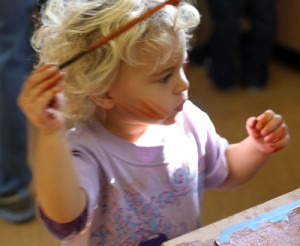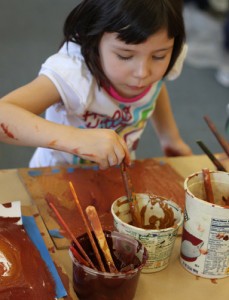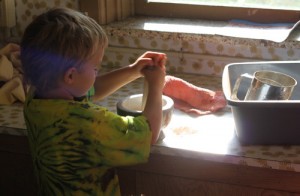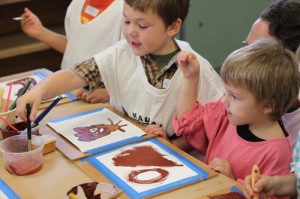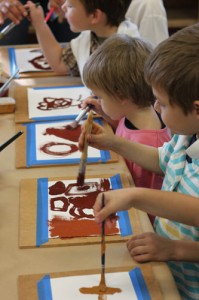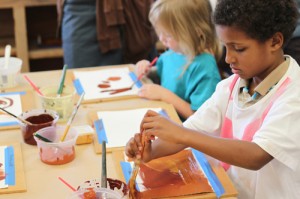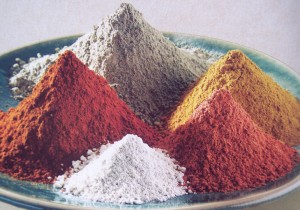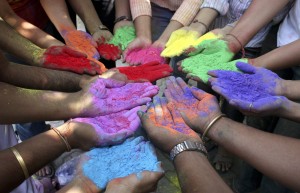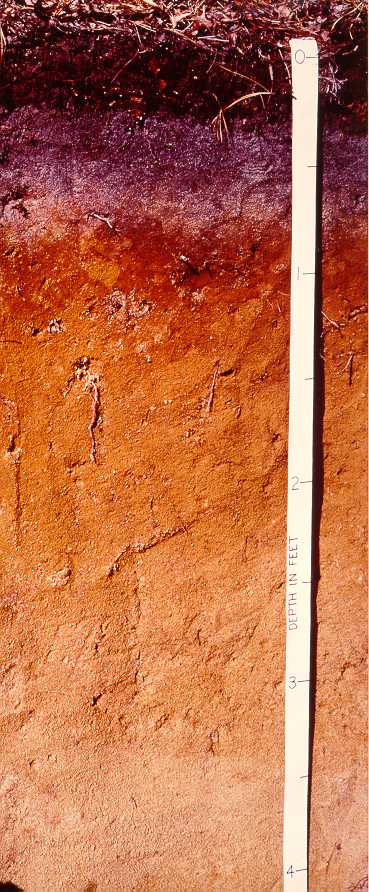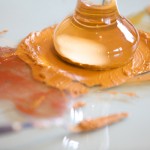g” alt=”” width=”300″ height=”199″ />I had the most wonderful opportunity to teach forty 4 -6 year olds how to make earth paints last week. It was glorious watching the ecstatic glee or intense concentration as they ground and sifted the pigments and composed beautiful little paintings. I’ve included a step-by-step guide for teaching children below the photos.
How to make Natural Earth Paints with children….
You’ll Need: mortar & pestel &/or flour sifter; walnut oil; small spatula or palette knife; piece of glass as palette or painting cups (recycled yogurt containers are good); a painting surface (canvas paper, canvas board, wood, or any surface that is primed with gesso); Murphy’s oil soap and regular soap (for clean up); either locally collected clay or purchased clay.
Step 1: Collect some clay: For a large group it may be best for an adult to pre-scout out a spot with clay visible and guide the group to the spot. But for a few children, you can go on a scouting trip together- along banks of rivers or streams, quarries, eroded areas. Or make it a game on road trips for them to watch out the window for pretty colors along the road cuts (bring some baggies in your car at all times in case you need to pull over). Note: How do you know it’s clay? A little creek water or spit mixed into a handful produces a tightly compacted ball. You can roll it further to become a long centipede of clay. It passes the test!
Step 2: Dry the clay: pour out a layer of clay on some newspaper or absorbent surface in the sun. This also allows any critters to escape before you start to grind. I usually put mine on a big table in front of a sunny window so the wind doesn’t blow it away.
Step 3: Grind the clay: Find a mortar & pestle and some flour sifters (the crank kind, not the handle squeeze kind) in a thrift store or antique shop. Set up tubs for the kids to grind the dry soil and then put it through the sifter to dispose of rocks and debris. Note: If the soil is not powder fine at the end you may need to push the soil through a small 100 grit screen as a last step (from a ceramic supply store).
Step 4: Mix with Walnut oil: For older kids, get a piece of window glass as a palette; Pour a small hill of powdered clay, make an indention in the top like a volcano, and pour in a little walnut oil (from the grocery store). Use a palette knife (or spatula) to mix it into a paste. For younger kids, either mix it for them and pour into little cups of paint or let them scoop powder into a cup, pour in a bit of oil and stir with a stick or spoon until you get a smooth tempera paint consistency.
Step 5: Paint!
Step 6: Clean up: Wipe as much paint off the brushes as possible with an old rag. Buy a cheap bottle of Murphy’s oil soap from the hardware store. Pour a little in a cup and swirl the dirty brushes around in it. Then rinse and then wash the brushes with a little soap and water (I use Dr. Bronners). Wash little hands with soap and water.
NOTE: You can skip steps 1, 2 & 3 if you purchase ready made pigments online. I sometimes buy beautiful blues, greens and purples onlline if I can’t find those colors in my area.
Rich Text Area Toolbar Bold (Ctrl + B) Italic (Ctrl + I) Strikethrough (Alt + Shift + D) Unordered list (Alt + Shift + U) Ordered list (Alt + Shift + O) Blockquote (Alt + Shift + Q) Align Left (Alt + Shift + L) Align Center (Alt + Shift + C) Align Right (Alt + Shift + R) Insert/edit link (Alt + Shift + A) Unlink (Alt + Shift + S) Insert More Tag (Alt + Shift + T) Toggle spellchecker (Alt + Shift + N) ▼ Toggle fullscreen mode (Alt + Shift + G) Show/Hide Kitchen Sink (Alt + Shift + Z) Add NextGEN Gallery Format – Paragraph Paragraph ▼ Underline Align Full (Alt + Shift + J) Select text color ▼ Paste as Plain Text Paste from Word Remove formatting Insert custom character Outdent Indent Undo (Ctrl + Z) Redo (Ctrl + Y) Help (Alt + Shift + H) I had the most wonderful opportunity to teach forty 4 -6 year olds how to make earth paints last week. It was glorious watching the ecstatic glee or intense concentration as they ground and sifted the pigments and composed beautiful little paintings. I’ve included a step-by-step guide for teaching children below the photos. How to make Natural Earth Paints with children…. You’ll Need: mortar & pestel &/or flour sifter; walnut oil; small spatula or palette knife; piece of glass as palette or painting cups (recycled yogurt containers are good); a painting surface (canvas paper, canvas board, wood, or any surface that is primed with gesso); Murphy’s oil soap and regular soap (for clean up); either locally collected clay or purchased clay. Step 1: Collect some clay : For a large group it may be best for an adult to pre-scout out a spot with clay visible and guide the group to the spot. But for a few children, you can go on a scouting trip together- along banks of rivers or streams, quarries, eroded areas. Or make it a game on road trips for them to watch out the window for pretty colors along the road cuts (bring some baggies in your car at all times in case you need to pull over). Note: How do you know it’s clay? A little creek water or spit mixed into a handful produces a tightly compacted ball. You can roll it further to become a long centipede of clay. It passes the test! Step 2 : Dry the clay : pour out a layer of clay on some newspaper or absorbent surface in the sun. This also allows any critters to escape before you start to grind. I usually put mine on a big table in front of a sunny window so the wind doesn’t blow it away. Step 3 : Grind the clay: Find a mortar & pestle and some flour sifters (the crank kind, not the handle squeeze kind) in a thrift store or antique shop. Set up tubs for the kids to grind the dry soil and then put it through the sifter to dispose of rocks and debris. Note: If the soil is not powder fine at the end you may need to push the soil through a small 100 grit screen as a last step (from a ceramic supply store). Step 4: Mix with Walnut oil: For older kids , get a piece of window glass as a palette; Pour a small hill of powdered clay, make an indention in the top like a volcano, and pour in a little walnut oil (from the grocery store). Use a palette knife (or spatula) to mix it into a paste. For younger kids , either mix it for them and pour into little cups of paint or let them scoop powder into a cup, pour in a bit of oil and stir with a stick or spoon until you get a smooth tempera paint consistency. Step 5: Paint! Step 6: Clean up: Wipe as much paint off the brushes as possible with an old rag. Buy a cheap bottle of Murphy’s oil soap from the hardware store. Pour a little in a cup and swirl the dirty brushes around in it. Then rinse and then wash the brushes with a little soap and water (I use Dr. Bronners). Wash little hands with soap and water. NOTE: You can skip steps 1, 2 & 3 if you purchase ready made pigments online. I sometimes buy beautiful blues, greens and purples onlline if I can’t find those colors in my area. Path : p

